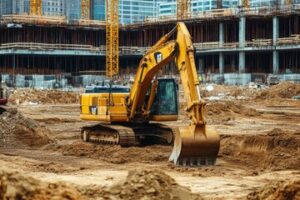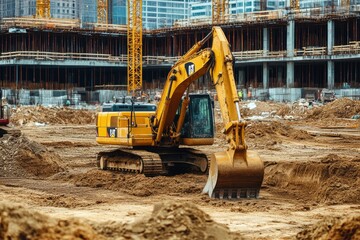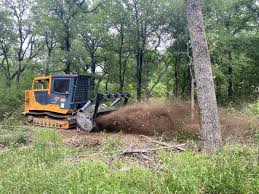Excavation Services play a crucial role in the foundation of construction and infrastructure projects. These services involve the careful and strategic removal of earth, rock, and other materials to create a stable base for buildings, roads, and other structures. The increasing complexity of construction projects has heightened the demand for skilled excavation professionals who can execute precise and efficient excavation work.
The process of excavation requires a deep understanding of soil composition, environmental impact, and safety protocols to ensure that the project is completed without causing damage to the surrounding area or compromising structural integrity. Excavation services are not only limited to construction but are also essential for landscaping, utility installation, and environmental restoration.
The process of excavation begins with thorough planning and site analysis. Before any digging takes place, excavation professionals conduct a detailed assessment of the site to determine the composition of the soil, the presence of underground utilities, and potential environmental hazards. This preliminary evaluation helps to identify any obstacles that could affect the excavation process, such as large rocks, unstable soil, or water sources. Proper planning ensures that the excavation process proceeds smoothly and reduces the risk of unexpected complications. Excavation professionals use advanced surveying equipment and techniques to map out the excavation area and establish precise boundaries. This information is essential for ensuring that the excavation work aligns with the overall design and engineering requirements of the project.
One of the most important aspects of excavation services is soil management. The type of soil at the excavation site determines the methods and equipment used for the job. Loose, sandy soil requires different handling techniques compared to dense clay or rocky terrain. Excavation professionals must be skilled in assessing soil conditions and selecting the appropriate equipment and methods for effective excavation. Proper soil management also involves stabilizing the surrounding area to prevent soil erosion and collapse. Techniques such as trenching, shoring, and sloping are used to reinforce the excavation site and maintain structural integrity. Managing soil displacement is also critical, as excess soil must be transported and disposed of in accordance with environmental regulations.
Safety is a top priority in excavation services, as working with heavy machinery and unstable ground presents significant risks. Excavation professionals are trained to follow strict safety protocols to protect both workers and the surrounding environment. This includes securing the excavation site, wearing protective gear, and using specialized equipment to prevent accidents. One of the most common hazards in excavation work is trench collapse, which can be prevented through proper shoring and bracing techniques. Excavation teams also monitor the site for signs of instability, such as shifting soil or water infiltration, and take immediate action to reinforce the site if necessary. Safety training and regular inspections are essential for minimizing the risk of accidents and ensuring that excavation work is carried out in compliance with industry standards.
Excavation services also play a key role in environmental protection and land restoration. Excavation projects often involve clearing land for construction, which can disrupt natural habitats and ecosystems. Excavation professionals work to minimize environmental impact by using eco-friendly methods and restoring the land after the project is completed. This may include replanting vegetation, creating drainage systems to prevent erosion, and preserving natural water sources. Excavation teams also handle the removal and disposal of hazardous materials, such as contaminated soil and construction debris, in accordance with environmental regulations. Sustainable excavation practices help to reduce the long-term environmental impact of construction projects and support the health of local ecosystems.
In addition to construction, excavation services are widely used for utility installation and repair. Underground utilities, such as water pipes, sewer lines, and electrical cables, require precise excavation work to avoid damage and ensure proper installation. Excavation teams use specialized equipment, such as vacuum excavators and hydro-excavation tools, to carefully expose and work around existing utility lines. This requires a high level of precision and coordination with utility companies and engineers. Excavation professionals must also be skilled in backfilling and compacting the soil after utility installation to prevent shifting and settling. Proper installation and repair of underground utilities are essential for maintaining the functionality and safety of infrastructure systems.
Excavation services are also essential for large-scale infrastructure projects, such as road construction, bridges, and tunnels. These projects require extensive excavation work to create a stable foundation and ensure structural integrity. Excavation teams work closely with engineers and construction crews to execute complex excavation plans that account for soil conditions, environmental factors, and load-bearing capacity. Advanced equipment, such as excavators, bulldozers, and backhoes, is used to remove large quantities of earth and rock quickly and efficiently. Excavation professionals must also coordinate with geologists and environmental specialists to address any geological challenges, such as rock formations or groundwater levels, that may affect the project.
The rise of modern excavation technology has significantly improved the efficiency and precision of excavation work. Excavation teams now have access to advanced equipment and machinery that can handle complex excavation tasks with greater accuracy and speed. GPS-guided excavators, laser leveling systems, and 3D modeling software allow excavation professionals to create detailed excavation plans and monitor progress in real-time. These technologies improve the accuracy of excavation work, reduce the risk of errors, and enhance overall project efficiency. Remote-controlled and automated excavation equipment also allows teams to perform excavation work in hazardous or hard-to-reach areas with minimal risk to workers. The integration of modern technology into excavation services has transformed the industry and set new standards for efficiency and quality.
Excavation services also require a high level of coordination and communication between multiple stakeholders. Excavation teams work closely with architects, engineers, project managers, and regulatory agencies to ensure that excavation work aligns with project goals and complies with all regulations. Effective communication is essential for addressing any challenges that arise during the excavation process and making adjustments as needed. Excavation professionals must also keep clients informed about project progress, potential delays, and any changes to the excavation plan. Clear communication and collaboration help to prevent misunderstandings and ensure that the project stays on track and within budget.
Excavation services also involve site preparation and land grading. Preparing a site for construction involves clearing debris, leveling the ground, and creating a stable foundation for building. Excavation teams use heavy equipment to remove trees, rocks, and other obstacles from the site. Grading involves shaping the land to create proper drainage and prevent water buildup. Proper site preparation and grading are essential for ensuring that the construction project proceeds smoothly and that the finished structure is stable and secure. Excavation professionals must have a strong understanding of soil composition, drainage patterns, and load-bearing capacity to execute site preparation and grading work effectively.
The demand for excavation services continues to grow as construction and infrastructure projects become more complex and ambitious. Skilled excavation professionals are in high demand for residential, commercial, and industrial projects. The ability to execute precise and efficient excavation work is essential for meeting the needs of modern construction and infrastructure development. Excavation teams that invest in training, technology, and safety measures are well-positioned to succeed in the competitive excavation industry. As the construction industry continues to evolve, the role of excavation services will remain essential for creating the foundation for safe and functional structures.

